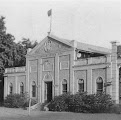(about 1784-1904)
At the end of 17th century there was unrest in the region of Saurashtra and assaults and looting by thugs and pendhari’s (earlier mercenaries of princely states who later resorted to looting and kidnapping) was a common feature. In one such incidence a house of one Muslim family in a village was ransacked and along with the loot their two infant children were also taken along.
One day, when this gang of pendhari’s was taking shelter in the forest of Gir (portion of Gir was part of Baroda state then), hunting party (shikari’s) of Baroda state, sent by the Maharaja appeared in that area. Listening to the sounds of gun fires the pendhari’s panicked and disbanded their camp in hurry. In that haste they forgot to carry with them the younger child who was about two and half to three years old who was playing little away from the group. Luckily the presence of this child was noticed by the hunting party, who after searching for its parents carried the child with them. The infant was brought to Baroda and was shown to the Maharaja and the Rajmata. Despite announcements and news paper advertisements no one came forwarded to claim the child. In a way the child was lucky as by this time Rajmata developed affection towards the infant and allowed him to stay in the palace premises. He was called Jangaliram, as he was found in the forest.
This Indian period was the golden age for Indian wrestling and Indian Marshall Arts and Baroda state was one of the foremost state in patronizing these arts. Several skilled persons were encouraged by the Maharaja giving them “peshgi and khoraki” (purse, food and shelter), along with the services of expert Ustad’s (skilled trainers) for their training. As Jangliram grew, he started attending Akhada (gymnasium) and began learning Gita and other Sanskrit scriptures and Doha’s of Kabir. God also blessed Jangliram with manly physique. Under the able guidance he became so efficient and skilful wrestler that he was always chosen by his Ustad's to fight with the challenging champions visiting Baroda. He mastered the various arts of sword, dagger, and lance fighting along with various skills of Malkhamb. Being the best exponent, he was made to demonstrate all these skills before any visiting dignitary to the state.
One day, while Jangliram was practicing wrestling in Akhada a heavily built youth with grand personality came their and watched him with fascination. When Jangliram finished his workout the youth told him that his name is Piroj and he is Janglirams brother. He told Jangliram that his real name is Jumma and they were separated from each other at an early age. Then Piroj took him to their mother who was ill and passed away soon. Jangliram then returned to Baroda but as Jumma.
Jummadada’s Akhada which started in a hut and later expanded by his favorite pupil Gajanan is named as Shree Jummadada Vyayam Mandir. This famous institution of Baroda, nurtured by his devoted pupil -Rajratna, Rajpriya, Prof. Manikrao is a real tribute to this saintly person Jummadada.

